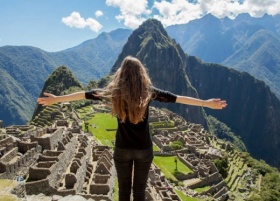Últimas Noticias
- Noticias
Feliz Navidad y prospero 2025
- Noticias
Descubrimientos arqueológicos en Venezuela: desentrañando civilizaciones antiguas
- Noticias
National Institute of Anthropology and History (INAH) find stone reliefs depicting cultural information about the Kaanu’l dynasty in Mexico.
- Noticias
Ranking de Empresas de Ciberseguridad: Los Líderes en la Protección Digital
- Noticias
Ranking of Cybersecurity Companies: A Look at the Industry Leaders
- Noticias
Similitudes entre Pierre Poilievre y Donald Trump
- Noticias
Here is what Canada can expect if it follows in the footsteps of the US elections
NOTICIAS
Descubrimientos arqueológicos en Venezuela: desentrañando civilizaciones antiguas
TORONTO. - Venezuela, una nación conocida por sus magníficos paisajes y ricos recursos naturales, también tiene muchos tesoros arqueológicos fascinantes que nos ayudan a iluminar la vida de las antiguas civilizaciones del lugar. Los descubrimientos realizados en este diverso país han revelado un complejo tapiz de culturas, que existía por mucho años antes del contacto europeo.
Ver másNational Institute of Anthropology and History (INAH) find stone reliefs depicting cultural information about the Kaanu’l dynasty in Mexico.
By Radu El Fakih Calina Columnist of Spanglish World Networks, La Ronda del Dia & La Portada Canada TORONTO. - At first glance, many of us may be inclined to dismiss the world of Mayan archaeology as washed out or lacking in recent discoveries but that couldn’t be further from the truth. In the past few decades, the archaeological community in Mexico has played a huge role in helping to further illuminate their past by finding a multitude of different artefacts and sites. Recently, in the lush green forest of the Yucatan Peninsula, their dedication to the past was proven once again as archaeologists working for INAH and the Federal Ministry of Culture discovered two new artefacts which could help us revolutionize our understanding of Mayan culture in the area. In the Dzibanché Archaeological Zone in Quintana Roo, archaeologists unearthed two stone platforms with stucco reliefs which are believed to belong to the Kaanu’l dynasty who ruled the lands of Mexico, Belize and Guatemala from around 250 to 650 AD. According to a statement given by INAH, the reliefs could play a huge role in furthering our understanding of Mayan culture in the area and period being looked at by highlighting the different beliefs and views held by said dynasty during what we now call the Early to Late Classic period in Mayan history. What did the reliefs actually represent? The reliefs themselves consisted of 3 different scenes located on platforms which were unearthed west of a Ball Court where the Mayans would have played Pitz which was an ancient sport/game popularized by the Mayans. This proximity to the Ball Court is fascinating as the game itself played a ceremonial role in the day-to-day lives of the inhabitants of this vast empire. Thus any depictions on the reliefs could potentially be associated with the game and its meanings. The first stucco relief depicts two guardians flanking a pedestal that would have typically held a statuette or sculpture of some kind and there are glyphs surrounding the two guardians which state the name of a potential ruler of the Kaanu’l dynasty. The use of the glyphs and the guardians could thus imply that the relief was used by the ruling dynast to help immortalize themselves as part of history or maybe even invoke protection by trying to associate themselves with idealised mythical guardians. The second relief, on the other hand, depicted potential ancestors and snakes inhabiting the night sky which were two characteristics that are often depicted in both Mayan and Teotihuacan iconography due to the strong prevalent belief in ancestor worship and the snake being representative of gods such Quetzalcoatl. This concept of myth and invoking the spiritual is then continued in the third and final relief which contains a multitude of different mythological creatures with the intertwined serpent playing a major role similar to the previous two reliefs. This recurring pattern of serpents could potentially be alluding to the ruling family trying to legitimize their reign by invoking the creator deity Quetzalcoatl, thus suggesting that their reign is ordained by the gods. This in itself may not be interesting at first glance, but this type of behaviour has been seen in many different cultures such as in Roman, Greek, and Egyptian culture where the rulers affirm that they have a divine right to rule either due to descending from the divine or being otherwise blessed by the divine. To conclude the archaeologists working on the Dzibanché Archaeological Zone in Quintana Roo have been playing a significant role in helping us discover more about Mayan culture and through this recent discovery have found potential evidence that the concept of legitimizing the rule of rulers was not only limited to the east but that said behaviour is potentially universal and not limited by distance, culture, or time period. One thing is for certain though, our understanding of Mayan culture is still quite limited but on the bright side that means that new and exciting discoveries are being made every day and I hope to take you on a journey every week discussing these new discoveries as well as learning more about the past together.
Ver másDescubriendo el exótico, lujoso y ardiente nuevo mundo de Dubái, con Dora Velez
Latinos en Canadá salieron a disfrutar del lejano oriente, su cultura, los Emiratos Árabes y sus encantos- Desde comienzo a fin como si tratara de un cuento de las mil maravillas todo fue perfecto. Los intrépidos viajeros se conectaron desde el vuelo directo de más de 13 horas a Dubái, y desde ahí todo se fue dando sin mayores contratiempos.
Ver másTORONTO EN UN DíA
Gracias a la oficina de turismo de Toronto, “Destination Toronto”, tuvimos la grata ocasión de visitar tres lugares imperdibles y un almuerzo en un restaurant ubicado en el centro de la ciudad.
Ver másDespués de la crisis generada por la pandemia, el turismo se está recuperando en Latinoamérica
Este dato se acompaña de las conclusiones del Mastercard Institute, según las cuales las reservas hechas desde EE.UU. hacia República Dominicana, México, Jamaica y Puerto Rico fueron en aumento un 84 %, 73 %, 65 % y 56 %, respectivamente, en comparación con las efectuadas antes de la pandemia, en 2019.
Ver másLas 10 ciudades y los 10 países que recomienda Lonely Planet visitar en el 2020
Por ciudades Salzburgo, Austria, ocupa el primer lugar y Bután es primero por países - Por Latinoamérica fueron destacados La Paz, Bolivia y Uruguay, y por Canadá Vancouver. Todo indica que este será el año de los viajes exóticos, pues en los rankings solo aparecen solo algunos de los destinos más populares, como Inglaterra, Países Bajos, Washington, D.C (Estados Unidos) y El Cairo (Egipto).
Ver másVancouver una de las 10 ciudades del mundo que se debe recorrer en bicicleta
TURISMO: Para Lonely Planet la ciudad canadiense solo es superada por Siena en Italia - El sitio de viajes publicó una lista de los 10 mejores lugares para tomar unas "vacaciones en bicicleta”.
Ver másSumérjase virtualmente en 15 bellos lugares del mundo recomendados por Google Maps
TURISMO: Si aún no los conoces de forma real, seguramente luego de verlos vas a querer ir - En la celebración de sus 15 años, Google Maps demostró que se pueden recorrer virtualmente más de 220 países y territorios del mundo, que ha logrado un registro fotográfico único de hermosos lugares sobre el planeta, y para conmemorar tan importante fecha la aplicación dio a conocer 15 bellos sitios en el planeta, que por su belleza natural, arquitectónica o paisajistas, todos los seres humanos deben visitar, de forma real o virtual, aquí esta listado que incluye la icónica Torre Eiffel, la Estación Espacial Internacional (ISS), La Sagrada Familia, en Barcelona y por Suramérica el Río Negro en el Amazonas, unas islas en el Lago Titicaca y por supuesto El Machu Pichu, en Perú.
Ver más









